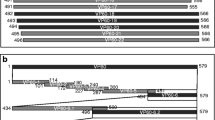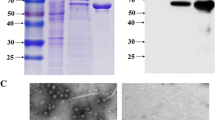Summary
Two monoclonal antibodies (MAbs), 1H10 and 1F10, have been selected against the denatured glycoprotein of the viral haemorrhagic septicaemia virus (VHSV) of salmonids by immunoblotting. Three reference VHSV serotypes (F1, F2, 23.75) and five VHSV isolates from either different host species (trout, salmon, barbel) or geographical locations in Spain reacted with both MAbs by ELISA. In vitro neutralization of all VHSV serotypes but not infectious haematopoietic necrosis virus (IHNV) was obtained only with MAb 1H10. However, when the MAb 1H10 (but not the non-neutralizing Mab 1F10) concentration was below 100µg/ml rather than neutralizing VHSV infectivity, plaque counts increased 2–3-fold. MAb 1H10 is unique in that it has both, an in vitro enhancing infectivity effect (not described yet for VHSV) and it recognizes denatured G protein in contrast to other previously described neutralizing MAbs against VHSV.
Similar content being viewed by others
References
Basurco B, Coll JM (1989) Spanish isolates and reference strains of viral haemorrhagic septicaemia virus show similar protein size patterns. Bull Eur Assoc Fish Pathol 9: 92–95
Basurco B, Coll JM (1989) Variabilidad del virus de la septicemia hemorrágica viral de la trucha en España. Med Vet 6: 425–430
Basurco B, Sanz F, Marcotegui MA, Coll JM (1991) The free nucleocapsids of the viral haemorrhagic septicaemia virus contain two antigenically related nucleoproteins. Arch Virol 199: 153–163
Bolognesi DP (1989) Do antibodies enhance the infection of cells by HIV? Nature 340: 431–432
Burstin SJ, Brandriss MW, Schlesinger JJ (1983) Infection of macrophage like cell line P388D, with reovirus; effects of immune ascitic fluids and monoclonal antibodies on neutralization and on enhancement of viral growth. J Immunol 130: 2915–2910
Clerx JPM, Horzinek MC, Osterhaus ADME (1978) Neutralization and enhancement of infectivity of non-salmonid fish rhabdoviruses by rabbit and pike immune sera. J Gen Virol 40: 297–308
Coll JM (1987) Injection of physiological saline facilitates recovery of ascitic fluids for monoclonal antibody production. J Immunol Methods 104: 212–222
De Kinkelin P (1972) Le virus d'Egtved. II Purification. Ann Rech Vet 3: 199–208
Estepa A, Basurco B, Sanz F, Coll JM (1991) Stimulation of adherent cells by the addition of purified proteins of viral haemorrhagic septicaemia virus to trout kidney cell cultures. Viral Immunol 4: 43–52
Gollins SW, Portefield JS (1986) A new mechanism for the neutralization of enveloped viruses by antiviral antibody, Nature 321: 244–246
Gould EA, Buckley A, Groegger BK, Cane PA, Doenhoff M (1987) Immune enhancement of yellow fever virus neurovirulence for mice: studies of mechanisms involved. J Gen Virol 68: 3105–3112
Lorenzen N, Olesen NJ, Jørgensen PEV (1988) Production and characterization of monoclonal antibodies to four Egtved virus structural proteins. Dis Aquat Organism 4: 35–42
Lorenzen N, Olesen NJ, Jørgensen PEV (1990) Neutralization of Egtved virus pathogenicity to cell cultures and fish by monoclonal antibodies to the viral G protein. J Gen Virol 71: 561–567
Martinez J, Coll JM (1988) Selection and clinical performance of monoclonal anti Creactive proteins in ELISA quantitative assay. Clin Chim Acta 176: 123–132
Mourton C, Bearzotti M, Piechaczyk M, Paulucci F, Pau B, Bastide JM, De Kinkelin P (1990) Antigen-capture ELISA for viral haemorrhagic septicaemia virus serotype I. J Virol Methods 29: 325–334
Peiris JSM, Gordon S, Ukeless JC, Porterfield JS (1981) Monoclonal anti-Fc receptor IgG blocks antibody enhancement of viral replication in macrophages. Nature 288: 189–191
Protefield JS (1986) Antibody-dependent enhancement of viral infectivity. Adv Virus Res 31: 335–355
Prabhakar BS, Nathanson N (1981) Acute rabbit rabies death mediated by antibody. Nature 290: 590–592
Sanz F, Coll JM (1992) Detection of viral haemorrhagic septicaemia virus by ELISA using two non-competitive monoclonal antibodies to the early nucleoproteins at high salt concentration. Am J Vet Res (in press)
Thiry M, Leoq-Xhonneux F, Dheur I, Renard A, De Kinkelin P (1991) Sequence of cDNA carrying the glycoprotein gene and part of the matrix protein M2 gene of viral haemorrhagic septicaemia virus, a fish rhabdovirus. Biochim Biophys Acta 1090: 345–347
Winton JR, Arakawa CK, Lannan CN, Fryer JL (1988) Neutralizing monoclonal antibodies recognize antigenic variants among isolates of infectious haematopoietic necrosis virus. Dis Aquat Organism 4: 199–204
Webb HE, Wight DGG, Platt GS, Smith CEG (1968) Langat virus encephalitis in mice I. The effect of the administration of specific antiserum. J Hyg 66: 343–354
Wolf K (1988) Fish viruses and fish viral diseases. Cornell University Press, Ithaca, NY
Author information
Authors and Affiliations
Rights and permissions
About this article
Cite this article
Sanz, F., Coll, J.M. Neutralizing-enhancing monoclonal antibody recognizes the denatured glycoprotein of viral haemorrhagic septicaemia virus. Archives of Virology 127, 223–232 (1992). https://doi.org/10.1007/BF01309586
Received:
Accepted:
Issue Date:
DOI: https://doi.org/10.1007/BF01309586




